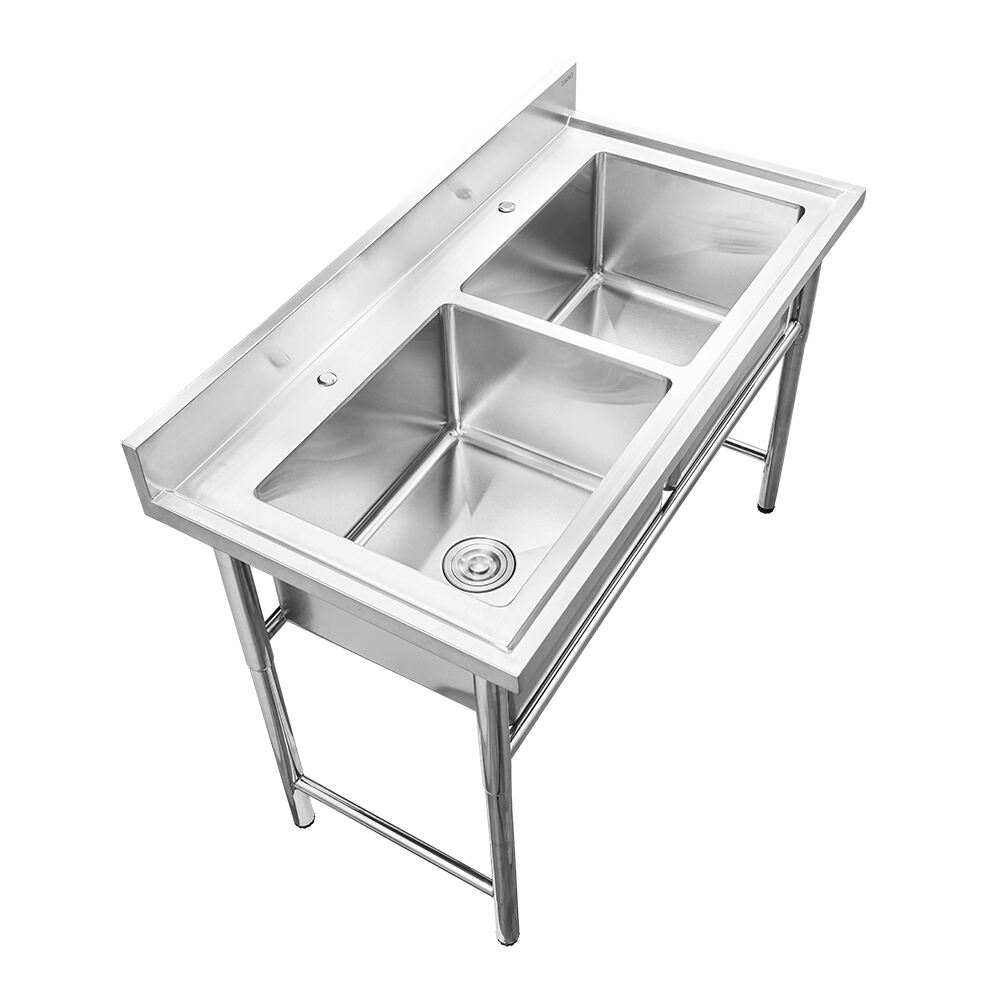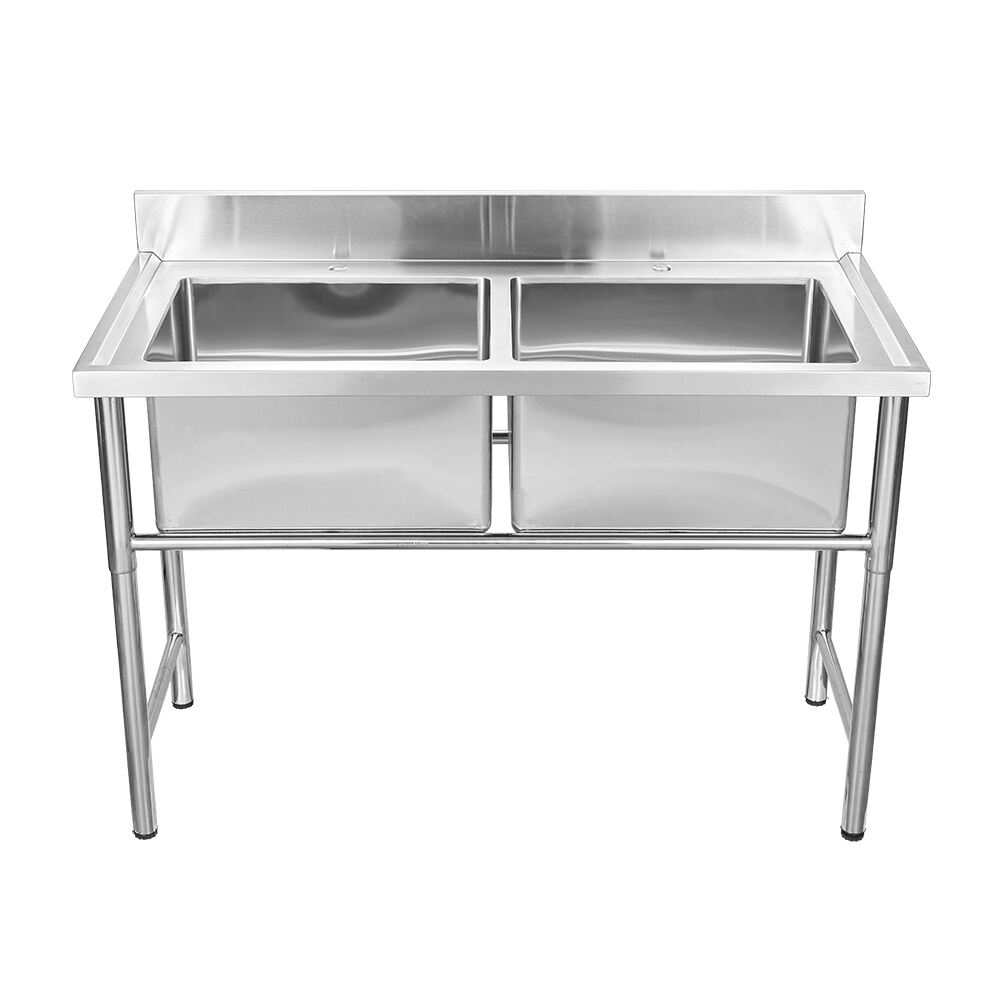Selección de materiales para Fregadero comercial Durabilidad
Grados de Acero Inoxidable (304 vs 316 vs 201)
Al considerar materiales para la durabilidad, los grados de acero inoxidable utilizados en la construcción de fregaderos comerciales tienen una gran influencia en la vida útil y la resistencia a la corrosión de un fregadero. El grado 304 es fácil de limpiar, un grado popular de acero inoxidable comúnmente utilizado para aplicaciones generales en la cocina. Sin embargo, más del 70% de las empresas de servicios de alimentación prefieren el grado 304 debido a su combinación de fuerza y costo-efectividad. En contraste, el tipo 316 de acero inoxidable incorpora molibdeno, lo que permite un aumento en las propiedades anti perforación y anti corrosión por iones cloruros. Esto lo hace ideal para la exposición a ambientes marinos o químicos. Pero es más caro que el 304, lo que lo pone fuera del alcance de muchas empresas a menos que sea requerido por un entorno específico.
El acero inoxidable de la serie 201 parece ser una alternativa más económica en comparación con los contrapartes a base de níquel más caros, ya que el 201 contiene mayores cantidades de manganeso y nitrógeno, que reemplazan al níquel. La serie 201 es más barata de producir y, aunque ofrece una resistencia a la corrosión similar a la de la serie 300, se utiliza predominantemente en entornos industriales y no tan agresivos. Las empresas deben considerar los requisitos de inversión inicial para grados más altos con el fin de promover la durabilidad y eficiencia en fregaderos comerciales.
Materiales compuestos para aplicaciones especializadas
Los compuestos compuestos tienen peso, apariencia y resistencia en la forma tradicional del tanque de acero al igual que otros. Estos fregaderos se fabrican a partir de la mezcla de dos o más componentes, desarrollando un fregadero que no solo es ligero sino que también resiste las manchas y los arañazos. Esta característica es especialmente importante en aplicaciones especializadas como el servicio de alimentos y las instalaciones médicas donde las superficies limpias y libres de gérmenes no solo son deseadas, sino requeridas. La no porosidad de los compuestos los hace resistentes al crecimiento de microorganismos, promoviendo así la higiene y la limpieza.
Desde un punto de vista práctico, varios de los tipos estándar de fregaderos están siendo eliminados de muchas cocinas comerciales, lo que comienza a romper algunas barreras presupuestarias, mientras se espera una mayor durabilidad y menos mantenimiento. Puedes leer testimonios reales de estas empresas que destacan grandes ahorros y un cierto grado de resistencia contra los embates del tiempo. También existen beneficios ambientales de los compuestos: muchos son 100% reciclables, coherentes con las tendencias sostenibles en el sector. Esta flexibilidad y bajo impacto ambiental hacen que los compuestos sean una opción atractiva para los entornos comerciales actuales que requieren soluciones únicas para fregaderos.
Impacto del grosor del material en la longevidad
El grosor de la pared es uno de los factores más importantes en la durabilidad e ingeniería de la vida útil de un fregadero comercial. El material grueso proporciona una mejor resistencia a los abolladuras y agujeros, siendo ideal para cocinas comerciales con mucho tráfico. Según los expertos, el grosor óptimo para la mayoría de los fregaderos de acero inoxidable es de 18 o 20 calibres, aunque algunos fregaderos están disponibles en 16 o 14 calibres. Ofrece una mejor protección en entornos pesados o con objetos afilados.
De acuerdo con la investigación, los fregaderos de calibre delgado tienden a fallar y las reparaciones son bastante costosas, por lo que es importante considerar las especificaciones correctas. La práctica industrial también promueve el uso de materiales más gruesos para abordar el deterioro a largo plazo, como el aflojamiento causado por un uso intensivo o la exposición del material a sustancias corrosivas. Por su parte, los expertos en ciencia de materiales especulan que el estándar futuro para el grosor del material cambiará en respuesta a la demanda comercial, y se volverá más grueso para adaptarse a formulaciones más ecológicas y duraderas que no solo satisfagan las necesidades de los consumidores hoy, sino también lo que requerirán en el futuro.
Diseños Ahorradores de Espacio para Cocinas Compactas
Beneficios de los Fregaderos Montados en la Pared
Los lavabos colgantes ofrecen una opción valiosa para cocinas ajustadas. Ayudan a ahorrar espacio en el suelo y simplifican la limpieza debajo del área del fregadero. Estos diseños fáciles de usar se pueden ajustar fácilmente de altura para una mejor ergonomía según la necesidad de cualquier usuario, especialmente útil en entornos comerciales de alta rotación. Esta flexibilidad proporciona comodidad y eficiencia para los trabajadores de la cocina, optimizando la producción. Los lavabos empotrados en la pared también son una tendencia visualmente atractiva con diseños modernos y elegantes que encajan perfectamente en la cocina de moda de hoy. FREGADEROS DE PISO O EMPOTRADOS EN LA PARED: El diseño ahorrador de espacio de los fregaderos de cocina comercial mejora el espacio de trabajo y la operación dentro de las mesas de trabajo de la cocina.
Instalaciones de Fregadero en la Esquina
Las colocaciones de fregaderos en las esquinas son una manera ingeniosa de utilizar el espacio en las esquinas ajustadas. Estilos de fregadero únicos optimizan las características mientras ahorran espacio en la encimera de la cocina. Provocarán una gran diferencia en la disponibilidad de trabajo, atractivo y bloqueo en cocinas concurridas. Fregaderos en esquina integrados bellamente que siguen la encimera, crean una interfaz general alineada y una excelente experiencia de cocción también. Las estadísticas destacan cómo los fregaderos en esquina han demostrado ser muy efectivos en el diseño de cocinas en términos de maximización del espacio y las implicaciones positivas en la facilidad de actividad en la cocina, lo que lleva a una psicología positiva.
Modelos bajo encimera vs. Modelos de colocación
Al comparar entre ellos, querrás considerar los dos aspectos problemáticos que cada tipo de fregadero tendrá en el proceso de instalación y la estética. Modelos bajo encimera: Los modelos bajo encimera ofrecen un aspecto contemporáneo o minimalista, y a menudo se eligen por su diseño limpio, aunque pueden ser más difíciles de ajustar. Sin embargo, los altavoces de colocación son mucho más simples de instalar y más fáciles de mantener, gracias a su ajuste plano. Ambos modelos impactan el diseño de la cocina de manera distinta; los fregaderos bajo encimera crean más espacio en la encimera en general, mientras que los fregaderos de colocación pueden ajustarse más fácilmente alrededor de las estructuras existentes de la encimera. Algunos profesionales del diseño recomiendan la colocación bajo encimera, ya que dicen que combina mejor con el estilo moderno; sin embargo, encuestas comerciales han mostrado que ambas preferencias pueden variar según la demografía hasta cierto punto, basándose en tendencias del mercado y otros factores comerciales.
Características de Rendimiento de Alto Volumen
Profundidad Óptima de la Cuenca para Uso Comercial
La profundidad de una pila es uno de los factores más importantes en la eficiencia general de las pilas comerciales. Las profundidades ideales de la pila son específicas para cada aplicación, pero normalmente están diseñadas para cumplir con los requisitos comerciales. Pocillos más profundos proporcionan suficiente espacio para lavar y limpiar. Por ejemplo, un estudio de productividad determinó que las empresas con profundidades de pocillo adaptadas a las condiciones de trabajo tuvieron en promedio un 20% de mejora en la eficiencia de lavado. Además, estudios ergonómicos indican que una pila con la profundidad correcta minimiza el cansancio del usuario y aumenta el confort en el flujo de trabajo. La pila debe tener una profundidad elegida para un rendimiento óptimo sin un uso excesivo de agua, mientras también acomoda la ergonomía del usuario proporcionando practicidad sin limitar la usabilidad bajo un uso intensivo.

Técnicas de Construcción Reforzada
Los fregaderos comerciales robustos incluyen características como una construcción de doble pared y refuerzos adicionales que aseguran un servicio duradero. Esto extiende significativamente la vida útil de los fregaderos, ahorrando el costo de múltiples mantenimientos y reemplazos. Para aplicaciones comerciales donde ahorrar tiempo significa ahorrar dinero, estos modelos trabajadores están garantizados para ser demandados y trabajar arduamente. Algunos, por ejemplo, han visto una reducción significativa en los incidentes de daño y fallo después de implementar fregaderos de doble pared en sus restaurantes. Las pruebas estándar de la industria y de terceros refuerzan la eficacia de estos métodos de refuerzo y garantizan que los fregaderos puedan soportar las demandas intensas del uso diario en cocinas comerciales mientras mantienen su fortaleza.
Drenaje Inclinado para una Limpieza Eficiente
Drenaje Inclinado Reforzado – Una parte integral de casi cualquier restaurante, bar o servicio de alimentos es un fregadero de calidad con un sistema de drenaje eficiente para evitar que quede agua estancada. La superficie inclinada del fregadero facilita naturalmente el flujo del agua hacia el desagüe, reduciendo considerablemente el tiempo de lavado y mejorando la experiencia del usuario en cualquier entorno comercial ocupado. Con un diseño de rejilla de buen sistema de drenaje, el agua de los platos mojados fluirá fácilmente al fregadero, protegiendo tu encimera de la cocina de la humedad y la suciedad. Las lecciones aprendidas de expertos en saneamiento sugieren que permitir un flujo eficiente en los fregaderos puede ayudar a evitar cuellos de botella en la limpieza. Investigaciones en la industria también respaldan estos hallazgos, con posibles ahorros de costos relacionados con mejores sistemas de drenaje, proporcionando ahorros en mano de obra y limpieza en entornos concurridos.
Estrategias de Mantenimiento y Eficiencia Costo-Efectiva
Protocolos de Limpieza Diaria
Las rutinas de limpieza diaria juegan un papel clave en mantener los fregaderos comerciales limpios y en buen estado durante muchos años. Los fregaderos vienen en una variedad de materiales y se utilizan para diversos propósitos, y cada uno requiere soluciones de limpieza específicas para evitar daños y funcionar correctamente. Por ejemplo, los fregaderos de acero inoxidable se limpian mejor con un limpiador no abrasivo que no raye, mientras que los fregaderos de piedra natural pueden beneficiarse de soluciones equilibradas en pH para evitar manchas. Seguir las instrucciones del fabricante es importante no solo para la longevidad de los fregaderos, sino también para evitar la anulación de la garantía debido a un mal uso. Los inspectores de salud frecuentemente mencionan fallas menores en el mantenimiento, como ignorar el área debajo del fregadero, donde puede prosperar el moho. Algunos productos recomendados, como limpiadores suaves para superficies metálicas o vinagre para eliminar depósitos de cal, pueden ayudar mucho cuando se limpia diariamente.
Prevenir la corrosión en entornos húmedos
Evitar que los fregaderos se corran en ambientes de alta humedad también requiere tácticas estratégicas como una buena ventilación y elegir los materiales de construcción adecuados. Los materiales comunes son el acero inoxidable o la porcelana, que resisten la oxidación y la corrosión. La alta humedad es también un factor clave en los problemas de corrosión; de hecho, investigaciones muestran que el mantenimiento por óxido es mayor en cocinas comerciales con ventilación insuficiente. Las mejores prácticas, según los expertos de la industria, incluyen instalar deshumidificadores, asegurarse de que circule el aire y aplicar recubrimientos protectores a las superficies de los fregaderos. Además, los agentes de limpieza de tipo ISO también son muy buscados, ya que se ha encontrado que reducen el riesgo de corrosión sin comprometer la limpieza.
Análisis de Costos del Ciclo de Vida
"¿Cuál es el costo del ciclo de vida de un fregadero comercial?" Un análisis del costo del ciclo de vida de los diversos tipos de fregaderos comerciales: El costo del ciclo de vida de un fregadero comercial te ayuda a saber cuánto ahorrarás con el tiempo según los diferentes tipos. Aunque los fregaderos baratos puedan parecer una solución rentable al considerar su bajo precio, la longevidad y los bajos requisitos de mantenimiento de los materiales premium significan ahorros a largo plazo. Los estudios muestran que comprar fregaderos duraderos puede garantizar un mayor retorno de la inversión (ROI) en comparación con opciones más baratas que necesitan ser reemplazadas regularmente. Estas observaciones se repiten a lo largo de las discusiones sobre la gestión de cocinas comerciales cuando se habla de que, debido a que un gasto inicial robusto reduce tanto los tiempos de inactividad como los intervalos de reemplazo, el verdadero beneficiado es el presupuesto operativo.
Preguntas frecuentes
P: ¿Cuáles son los beneficios de usar acero inoxidable de grado 316 para fregaderos comerciales?
A: El acero inoxidable de grado 316 ofrece una resistencia superior a la corrosión y al picado, lo que lo hace ideal para entornos expuestos a químicos duros o condiciones marinas.
Q: ¿Por qué podría elegir un negocio materiales compuestos para sus fregaderos?
A: Los materiales compuestos ofrecen ventajas como un peso más ligero, una mayor resistencia a las manchas y características de sostenibilidad, lo que los hace adecuados para aplicaciones especializadas que requieren higiene y eficiencia.
Q: ¿Cómo influye el grosor del material en la durabilidad del fregadero?
A: Los materiales más gruesos tienden a resistir mejor los impactos físicos, reduciendo daños como abolladuras y rayones, lo que contribuye a la longevidad de los fregaderos comerciales.
Q: ¿Cuáles son los beneficios de los diseños de fregadero montados en la pared?
A: Los fregaderos montados en la pared ahorran espacio en el suelo, mejoran la limpieza y ofrecen opciones de altura personalizables, mejorando la ergonomía y la productividad en distribuciones de cocina compactas.
Q: ¿Cómo puede mejorar el drenaje inclinado el rendimiento del fregadero?
A: La evacuación inclinada minimiza la acumulación de agua, lo que facilita la limpieza y mejora la higiene en entornos de alto uso como cocinas comerciales.



